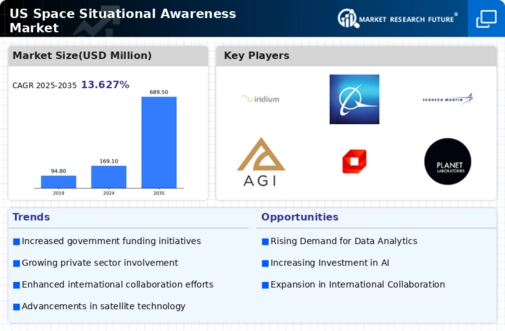The space situational awareness market is characterized by a dynamic competitive landscape, driven by the increasing demand for advanced monitoring and tracking systems in space. Key players such as Northrop Grumman (US), Lockheed Martin (US), and Raytheon Technologies (US) are at the forefront, each adopting distinct strategies to enhance their market positioning. Northrop Grumman (US) focuses on innovation through the development of cutting-edge satellite technologies, while Lockheed Martin (US) emphasizes strategic partnerships to bolster its capabilities in data analytics and sensor technologies. Raytheon Technologies (US) appears to be concentrating on integrating artificial intelligence into its systems, thereby enhancing operational efficiency and decision-making processes. Collectively, these strategies contribute to a competitive environment that is increasingly reliant on technological advancements and collaborative efforts.
In terms of business tactics, companies are localizing manufacturing and optimizing supply chains to enhance responsiveness and reduce costs. The market structure is moderately fragmented, with several key players exerting considerable influence. This fragmentation allows for a variety of approaches to space situational awareness, fostering innovation and competition among established firms and emerging players alike.
In November 2025, Northrop Grumman (US) announced a partnership with NASA (US) to develop next-generation satellite systems aimed at improving space traffic management. This collaboration is strategically significant as it aligns with the growing need for enhanced situational awareness in increasingly congested orbital environments. By leveraging NASA's expertise and resources, Northrop Grumman (US) is likely to strengthen its position in the market and enhance its technological capabilities.
In October 2025, Lockheed Martin (US) unveiled a new data analytics platform designed to integrate information from various space assets, thereby providing real-time insights for military and commercial applications. This initiative underscores Lockheed Martin's commitment to digital transformation and positions the company to capitalize on the increasing demand for integrated solutions in space situational awareness. The platform's capabilities may significantly enhance decision-making processes for its clients, thereby solidifying Lockheed Martin's competitive edge.
In September 2025, Raytheon Technologies (US) launched an advanced AI-driven sensor suite that promises to improve the detection and tracking of space debris. This development is crucial, as the proliferation of space debris poses a significant risk to operational satellites and space missions. By integrating AI into its sensor technologies, Raytheon Technologies (US) is likely to enhance its offerings and address a pressing concern within the industry, potentially leading to increased market share.
As of December 2025, current trends in the space situational awareness market include a pronounced shift towards digitalization, sustainability, and AI integration. Strategic alliances are increasingly shaping the competitive landscape, enabling companies to pool resources and expertise to tackle complex challenges. Looking ahead, competitive differentiation is expected to evolve, with a greater emphasis on innovation and technology rather than price-based competition. Companies that can reliably deliver advanced solutions while ensuring supply chain resilience are likely to emerge as leaders in this rapidly evolving market.





















Leave a Comment